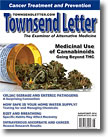|
![]()
From the Townsend Letter |
||||||||||||||||||||||||||||||||||||||||||||||||||||||||||||||||||||||||||||||||||||||||||||||||||||||||||||||||||||||||||||||||||||||||||||||||||||||||||||||||||||||||||||||||||||||||||
Reactions to Sub-Lingual Immunotherapy: An Analysis of a Group of Patients Who Developed Adverse Events over a Period of 5 Years Does Glycerin play a role? by Diego Saporta, MD |
||||||||||||||||||||||||||||||||||||||||||||||||||||||||||||||||||||||||||||||||||||||||||||||||||||||||||||||||||||||||||||||||||||||||||||||||||||||||||||||||||||||||||||||||||||||||||
|
The first four symptoms in Table 4 account for 35.9% of the complaints (37/103), and the first 5 symptoms account for 40.8% of the complaints (42/103). Itching/rash of the skin is by far the most common complaint, and it is not necessarily limited to the perioral area. In bold we have identified the complaints that are reported in the literature as "local reactions."2 The majority of the patients reported either 1 or 2 symptoms (see Table 5). Table 5: Number of Reported Symptoms
Total number (percentage) Symptom Groups Table 6: Symptoms Arranged by Groups
Table 7: Groups Arranged by Frequency
#: Number of times a symptom pertaining to a group is reported The groups OP (17 cases) and GI (14 cases) hold what has been reported as local reactions for a total of 31 cases or 30.1%.2 The remaining AEs include 72 cases (skin: 38, respiratory: 14, constitutional: 11, psychoneurological: 6, and nasal: 3), or 69.9%. All these can be classified as systemic AEs. If GI symptoms were considered systemic AEs, the percentage would increase to 83.5%. We have classified itchy lips (1 case) in the skin group and taste-related complaints (2 cases) in the psychoneurological group. Even counting these 3 cases as local reactions, we would have a total of 34 cases, or 33.0%; therefore, it is clear that the majority of the reactions in this report are systemic (even more so if GI symptoms are counted as systemic reactions). The groups skin, OP, and GI hold the symptoms reported in the literature as the "common" or "usual" AEs, and the groups skin, nasal, and respiratory hold most of the symptoms reported as systemic.2,14,27-29 Symptoms grouped under constitutional and psychoneurological are not very prevalent. They are not commonly reported either, but they can clearly be classified as systemic. Patient Management
Decrease/Increase Number of Drops Discontinue and Restart Diluting Treatment Bottle
Divide Dose The majority of the patients were managed with one intervention, but some required more (see Table 8). Table 8: Number of Interventions for AE Management
Final Outcome Table 9: Patients Who Quit After AE Onset
To further assess this finding, a group of 100 charts from patients on SLIT was randomly collected. Defining "quitting" as not ordering bottles for more than two consecutive cycles (6 weeks for each cycle during escalation), we found that 27 patients had quit and another 7 patients had an indeterminate status. Therefore in this group of 100 nonselected SLIT patients, 27.0% to 34.0% quit treatment for reasons not necessarily related to the development of AEs. Note that this number is similar to the 31% rate of treatment discontinuation reported in the literature.28 Special circumstances Gastrointestinal symptoms The patients in the GI group have somewhat different clinical characteristics than those in the non-GI group. This will be discussed in Tables 10 through 14. All comparisons will be done between the 2 subgroups extracted from the total sample: the GI group vs. the non-GI group. Table 10 shows that GI symptoms, in agreement with reported literature, occur with similar frequency in adults and children.9 Table 10: GI Demographics
Table 11 analyzes the absolute numbers and the percentages of patients who are either active or have quit treatment. While 83.0% of the patients in the non-GI group have quit at the time of data collection, this percentage increased to 93.3% when considering the GI group (14 out of the 15). Considering the subgroup of patients who quit within 3 months, there also appears to be a difference with 40.0% of the GI group having quit within 3 months versus 34.0% in the non-GI group. However the results of a chi-squared (χ2 ) test revealed no statistical difference between these two results. The small sample size may influence the lack of statistical significance, but the different percentages may suggest that patients in the GI group are more likely to quit. Table 11: Active and Nonactive Patients
TS: Total sample (62 cases) |
||||||||||||||||||||||||||||||||||||||||||||||||||||||||||||||||||||||||||||||||||||||||||||||||||||||||||||||||||||||||||||||||||||||||||||||||||||||||||||||||||||||||||||||||||||||||||
![]()
Consult your doctor before using any of the treatments found within this site.
![]()
Subscriptions
are available for
Townsend Letter, the Examiner of Alternative Medicine
magazine, which is
published 10 times each year. Search our pre-2001
archives for further information. Older issues of the printed magazine
are also indexed for your convenience.
1983-2001
indices ; recent indices. Once you find the magazines you'd like to order, please
use our
convenient form, e-mail subscriptions@townsendletter.com,
or call 360.385.6021.
360.385.6021
Fax: 360.385.0699
info@townsendletter.com
Who are
we? | New articles | Featured
topics | e-Edition |
Tables of contents | Subscriptions | Contact
us | Links | Classifieds | Advertise |
Alternative
Medicine Conference Calendar | Search site | Archives |
EDTA Chelation Therapy | Home
© 1983-2014 Townsend Letter
All rights reserved.
Website by Sandy
Hershelman Designs




